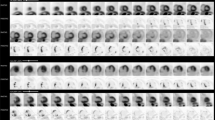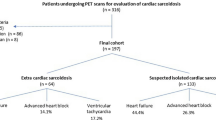Abstract
Background
Cardiac positron emission tomography (PET) using 18F-fluorodeoxyglucose (FDG) has been used to diagnose and monitor cardiac sarcoidosis (CS). It is not known whether a reduction in myocardial inflammation, as measured by FDG uptake, is associated with improvement in LV ejection fraction (EF).
Methods
For 23 patients with CS followed by a total of 90 serial PET exams (median 4 per patient), two physicians blinded to EF quantified the maximum of standardized uptake value (SUV) and volume of inflamed tissue above two distinct thresholds to assess the intensity and extent of FDG uptake on each study. Using gated 82Rubidium rest myocardial perfusion images, EF was measured blinded to all clinical and FDG data. To account for clustering and differences in scan frequency, a longitudinal mixed effects model was used to evaluate the relationship between FDG uptake and changes in EF on interval scans.
Results
Among 23 patients with serial PET exams (mean age 49, 74% male, mean baseline EF 43% ± 13%), the median time between the first and last scan was 2.0 years. Overall, 91% were treated with corticosteroids, 78% with ACE/ARB, 83% with beta-blockers, and 83% had ICDs. Longitudinal regression demonstrated a significant inverse linear relationship between maximum SUV and EF with an expected increase in EF of 7.9% per SUV reduction of 10 g·mL−1 (P = .008). Likewise, in an analysis based on volume, there was an increase in EF of 2.1% per 100 cm3 decrease in volume of inflamed tissue using a threshold of 2.7 g·mL−1 (P = .028) and an increase in EF of 3.8% per 100 cm3 decrease (P = .022) using a SUV threshold of 4.1 g·mL−1.
Conclusions
In a longitudinal cohort of CS patients, a reduction in the intensity and extent of myocardial inflammation on FDG PET is associated with improvement in EF. These data suggest serial PET scanning may help guide titration of immunosuppressive therapy to improve or prevent heart failure in CS.




Similar content being viewed by others
References
Iannuzzi MC, Fontana JR. Sarcoidosis: Clinical presentation, immunopathogenesis, and therapeutics. J Am Med Assoc 2011;305:391-9.
Silverman KJ, Hutchins GM, Bulkley BH. Cardiac sarcoid: A clinicopathologic study of 84 unselected patients with systemic sarcoidosis. Circulation 1978;58:1204-11.
Yazaki Y, Isobe M, Hiroe M, Morimoto S, Hiramitsu S, Nakano T, et al. Prognostic determinants of long-term survival in Japanese patients with cardiac sarcoidosis treated with prednisone. Am J Cardiol 2001;88:1006-10.
Schliamser JE, Kadish AH, Subacius H, Shalaby A, Schaechter A, Levine J, et al. Significance of follow-up left ventricular ejection fraction measurements in the Defibrillators in Non-Ischemic Cardiomyopathy Treatment Evaluation trial (DEFINITE). Heart Rhythm 2013;10:838-46.
Chiu CZ, Nakatani S, Zhang G, Tachibana T, Ohmori F, Yamagishi M, et al. Prevention of left ventricular remodeling by long-term corticosteroid therapy in patients with cardiac sarcoidosis. Am J Cardiol 2005;95:143-6.
Grutters JC, van den Bosch JM. Corticosteroid treatment in sarcoidosis. Eur Respir J 2006;28:627-36.
Nery PB, Leung E, Birnie DH. Arrhythmias in cardiac sarcoidosis: Diagnosis and treatment. Curr Opin Cardiol 2012;27:181-9.
Youssef G, Beanlands RS, Birnie DH, Nery PB. Cardiac sarcoidosis: Applications of imaging in diagnosis and directing treatment. Heart 2011;97:2078-87.
Blankstein R, Osborne M, Naya M, Waller A, Kim CK, Murthy VL, et al. Cardiac positron emission tomography enhances prognostic assessments of patients with suspected cardiac sarcoidosis. J Am Coll Cardiol 2013. doi:10.1016/j.jacc.2013.09.022.
Okumura W, Iwasaki T, Toyama T, Iso T, Arai M, Oriuchi N, et al. Usefulness of fasting 18F-FDG PET in identification of cardiac sarcoidosis. J Nucl Med 2004;45:1989-98.
Ohira H, Tsujino I, Yoshinaga K. (1)F-Fluoro-2-deoxyglucose positron emission tomography in cardiac sarcoidosis. Eur J Nucl Med Mol Imaging 2011;38:1773-83.
Dorbala S, Vangala D, Sampson U, Limaye A, Kwong R, Di Carli MF. Value of vasodilator left ventricular ejection fraction reserve in evaluating the magnitude of myocardium at risk and the extent of angiographic coronary artery disease: A 82Rb PET/CT study. J Nucl Med 2007;48:349-58.
Kida K, Yoneyama K, Kobayashi Y, Takano M, Akashi YJ, Miyake F. Late gadolinium enhancement on cardiac magnetic resonance images predicts reverse remodeling in patients with nonischemic cardiomyopathy treated with carvedilol. Int J Cardiol 2013;168:1588-9.
Lower EE, Baughman RP. Prolonged use of methotrexate for sarcoidosis. Arch Intern Med 1995;155:846-51.
Schuller JL, Zipse M, Crawford T, Bogun F, Beshai J, Patel AR, et al. Implantable cardioverter defibrillator therapy in patients with cardiac sarcoidosis. J Cardiovasc Electrophysiol 2012;23:925-9.
Betensky BP, Tschabrunn CM, Zado ES, Goldberg LR, Marchlinski FE, Garcia FC, et al. Long-term follow-up of patients with cardiac sarcoidosis and implantable cardioverter-defibrillators. Heart Rhythm 2012;9:884-91.
Boellaard R. Need for standardization of 18F-FDG PET/CT for treatment response assessments. J Nucl Med 2011;52:93S-100S.
Boellaard R. Standards for PET image acquisition and quantitative data analysis. J Nucl Med 2009;50:11S-20S.
Disclosure
None.
Author information
Authors and Affiliations
Corresponding author
Additional information
Funding
None.
Appendix
Appendix
See Figure 5.
Rights and permissions
About this article
Cite this article
Osborne, M.T., Hulten, E.A., Singh, A. et al. Reduction in 18F-fluorodeoxyglucose uptake on serial cardiac positron emission tomography is associated with improved left ventricular ejection fraction in patients with cardiac sarcoidosis. J. Nucl. Cardiol. 21, 166–174 (2014). https://doi.org/10.1007/s12350-013-9828-6
Received:
Accepted:
Published:
Issue Date:
DOI: https://doi.org/10.1007/s12350-013-9828-6





